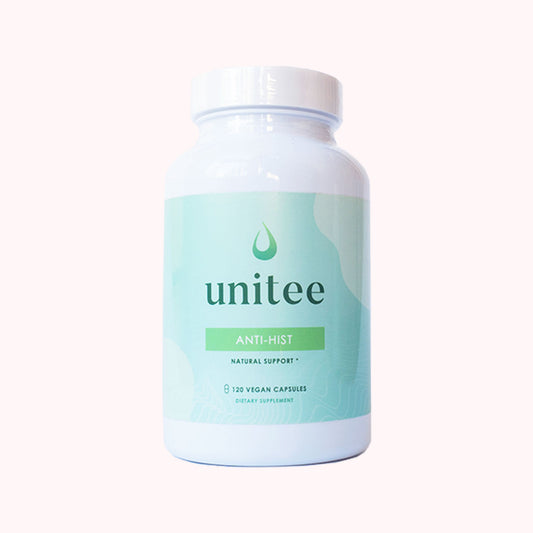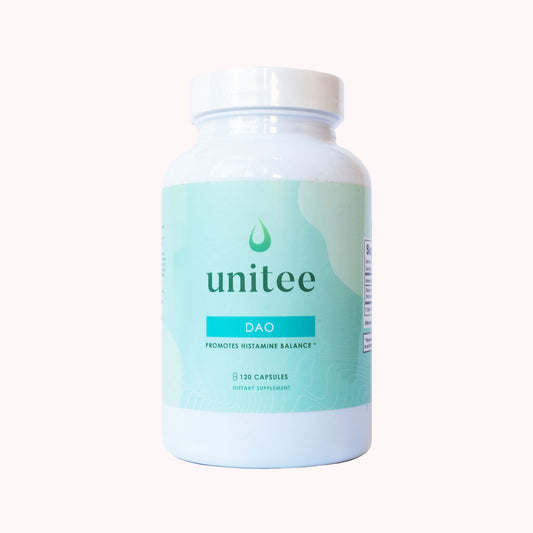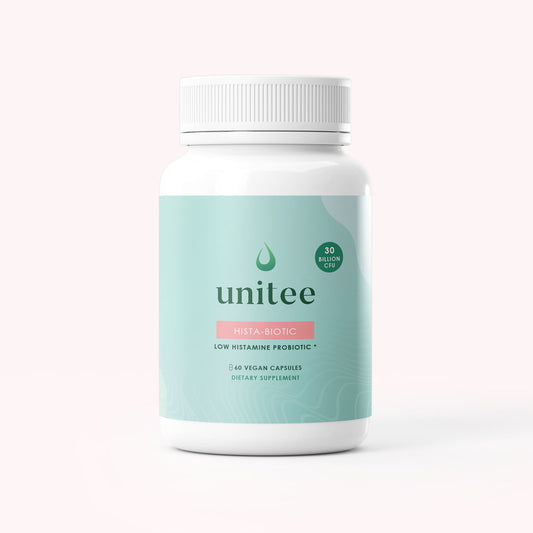Most histamine intolerant individuals are working to rebalance their gut bacteria using histamine safe probiotics. This is because bacterial issues and histamine intolerance tend to go hand-in-hand.
But, did you know that there's a particular bacterium called H. pylori that has shown to play a role in histamine intolerance? It's true. This bacteria is actually carried by up to half of the population (1)! You may be wondering then, why there aren't far more people living with histamine intolerance because of it. Well, the reason for this is that many people aren't bothered by the presence of H. pylori. Or, the bacteria is not present in the amount needed to be bothersome! Additionally, many people may not have trouble with their digestive system to begin with, so the presence of H. pylori doesn't cause problems because they do not have already compromised systems.
Not only is there a strong connection between H. pylori and histamine intolerance, but many individuals experiencing common issues such as reflux and inflammation that they associate with their intolerance to histamine. These symptoms may actually be brought on as a result of dealing with an H. pylori infection that is compounding their condition.
H. Pylori has even more sinister associations to poor health. It has been linked to the cause of more serious medical complications such as esophageal cancer, and this is because of the way H. pylori plays a role in cancer's pathogenesis.
In order to prevent the more serious effects on health that H. pylori can have, let's take a deeper dive into what it is and how to tell if you're affected, so that you can take action right away.
Let's take a closer look.
What is Helicobacter pylori?
Let’s start with the basics: Helicobacter pylori (H. pylori), is a strain of bacteria that infects the stomach lining and has been recorded as a major contributor and cause of ulcers in the stomach, distress on the small intestine and other gastroduodenal diseases (1).
This nasty bacteria can be passed along through saliva or fecal matter from an infected individual. The most common way that H. pylori is transmitted is through the sharing of utensils, food and water (2)(3). Even swimming in contaminated water can pose a risk of infection.
Although not as prevalent in developed countries like North America and Europe, H.Pylori is still a factor in many people's lives. The trouble is, that because it may not be as much a risk in these parts of the world, it has a tendency to be brushed off very quickly by some medical professionals as something far less severe. Of course, this can lead to numerous misdiagnoses that leads to a continuation of symptoms such as acid reflux and heartburn. Without a proper diagnosis and medical treatment, an H. pylori infection can even cause a worsening of symptoms that include nausea and sometimes the development of stomach ulcers (4).
As mentioned at the start of this post, approximately half of the world's population lives with H. pylori in their digestive tracts, and many live with it asymptomatically. This is a factor that contributes to the underwhelm that people with H. pylori infections receive from the medical system. In addition, people who experience everyday symptoms like reflux and heartburn are often blamed for their own demise. Their symptoms are just chalked up to being caused by the way they eat, and what they choose to eat! The insinuation here then, is that should they make simple changes to their diet and lifestyle, all will be well.
Well, as we now know, it's really not that simple. These symptoms are not normal and can be indicators that something far more serious is going on. Additionally, these symptoms can develop into more severe disorders - so, it's best to put a stop to them early on.
So what about histamine?
A Short Recap on Histamine Intolerance
Histamine is a key chemical in the body that is derived from histidine, which is a fundamental amino acid associated with the growth and repair of tissues in the body (4).
Histamine is the compound released by the body when allergies and inflammatory reactions come up. It's the warning alarm send out to the rest of the body that there's an invader (ie. bacteria, infection, etc.) and it needs to be dealt with (5).
This warning signal is an important pathway that maintain a healthy body and immune system. It protects you from unwanted foreign aggressors that could cause health problems.
But, the trouble comes in when that signal goes off while an invader isn’t actually present. This is where histamine intolerance comes in (2). Hypersensitivity reactions take place when histamine is released from the body when there is no actual threat, and this can cause histamine to be released at the wrong times, or for far too long, which causes histamine levels to build up in the body.
While certain levels of histamine are well tolerated, when those levels exceed the normal range, any additional histamine released or external histamine sources entering the body can cause severe allergic-like reactions. It's now that all of the bothersome and serious symptoms that result start to occur.
H. Pylori and Histamine Intolerance
H. pylori and histamine can be a menacing combination.
H. pylori, because it's a foreign bacteria invading the digestive tract, releases toxins called lipopolysaccharides; LPS for short. These LPS cause histamine to be released from the mast cells lining the stomach. And because this is a consistently occurring event, histamine levels build up.
Now, consider all of the other digestive factors that can, at the same time, be causing histamine levels to build. Histamine increases when there is leaky gut, bacterial overgrowth (including SIBO), allergies (IgE), bleeding from the digestive tract (most commonly cause by ulcers), chronic illnesses and diets high in histamine-rich foods (7).
You can now start to create a clear picture as to why the combination of H. pylori and other histamine intolerance factors can be the cause of such severe and bothersome symptoms!
There's another issue around a co-existing H. pylori infection and histamine intolerance. H. pylori is best treated with antibiotics, but resistance to these types of antibiotics is increasing, which means H. pylori becomes stronger in its ability to infect, and antibiotics may not be able to wipe them out. With this being a risk for re-infection, the problem with mis- and non-diagnosis and a serious lack of research and studies regarding effective alternative therapies (8), H. pylori may become a greater problem for more people in the future, not just those of you with histamine intolerance.
Right now, however, let's look at where you go from here if you do happen to be living with H. pylori and histamine intolerance.
H. Pylori: Tests and Diagnosis
Healthcare professionals as well as many in the health and wellness industry as a whole currently have a tendency to approach both H. pylori and histamine intolerance with skepticism and a lack of recognition or underestimation of it's importance in health and disease.
But the evidence is changing! And along with it, it's important for the industry mindset to change about it. We need to be more open-minded when it comes to how different strains of bacteria - especially ones as common and potentially harmful as H. pylori - interact with the body and cause symptoms; no matter how unimportant or common they may seem.
Even if H. pylori and histamine intolerance don't commonly appear to be immediately life threatening, it doesn't mean that both H. pylori and histamine don't have the potential to develop into more harmful symptoms and chronic disorders. And it's absolutely important to recognize that even if the symptoms are only bothersome for one person, it needs to be addressed!
For this reason, the presence of H. pylori is important to check for and it's presence should not be taken lightly, especially as it can wreak severe havoc on the whole body, and not just the gut.
Our body works as a whole - with no system functioning in complete isolation. So, if there is a bacteria that can weed its way into the lining of your stomach, you had best believe it will affect your entire being – which, many people observe as skin issues, inflammation, allergies, sensitivities and other symptoms... ones you also commonly associate with histamine intolerance.
You may be chomping at the bit to get tested for H. pylori and wondering where and how you can do so.
Unfortunately, it's not that simple. More often than not, if you haven’t developed an ulcer, or your symptoms don't present in a certain way that makes your doctor think it's serious, your healthcare provider will not test you for H. pylori. It's likely they're going to prescribe you an acid suppressant instead, which not only doesn't deal with the root cause of your condition, it may make it easier for this bacteria to spread to others but also make it more difficult for you to get on top of your symptoms and actually heal your body (8).
Knowledge is power, so knowing your options and being able to request the right tests and/or examinations in this regard is key.
There are essentially four testing options for H. pylori. A urea breath test, blood test, stool test and internal examination of the stomach can all be used for diagnosis. The most accurate method is the internal stomach examination in which a biopsy is taken from the stomach lining while a physician is performing an esophagogastroduodenoscopy, commonly called an endoscopy. The trouble is that this procedure is highly invasive and comes with a variety of risks, and so is only performed when absolutely necessary. The most common method, therefore, for diagnosis, is either a blood or stool test. An endoscopy may or may not follow a positive blood or stool test.
Once diagnosed, eradication of H. pylori comes next. Eradication can be done in multiple ways, through either herbal or pharmaceutical antibiotics. Your preference depends on the type of healthcare professional you're dealing with and your personal case.
Depending on how long you’ve been dealing with this bacteria and how severe the infection is, antibiotics may be the only way to truly rid yourself of H. pylori.
In addition, there are several natural ways to support your body through an H. pylori infection. These options are also tailored to support you in your journey to healing from histamine intolerance; a one-two punch against these two nasty conditions.
H. Pylori and Histamine Symptoms: Top 7 Natural Interventions
When it comes to H. pylori and histamine intolerance, numerous alternative therapies have shown success in their ability to help your to regain control over H. pylori while also healing your gut and body (8):
-
Probiotics have shown great success in not only helping to eradicate H. pylori, but possibly preventing reinfection. We know for sure that they're associated with healing the stomach and the rest of the digestive tract, which means they're definitely a great addition, especially bifidobacterium. (4,8). It's essential to ensure you're using probiotics that are histamine-safe in your H. pylori eradicating routine. Many probiotics will naturally produce histamine and actually make histamine intolerance symptoms worse, which we definitely want to avoid. Ensure you check this list I've compiled of high histamine bacteria, and avoid using any probiotic products containing these common strain. This is my favourite low histamine probiotic.
-
Berberine has not only shown direct activity against H. pylori itself, but it may even possess the potential to improve histidine metabolism. As histidine is a precursor for histamine, this improvement in histidine metabolism offers potential benefits for individuals with histamine intolerance, giving it a double-edged effect against both the H. pylori and histamine issues themselves (9).
-
Zinc has shown to reduce inflammation associated with H. pylori as well as potential symptoms and complications associated with H. pylori infections, such as gastritis (10, 11). Additionally, the use of zinc in combination with antibiotics has shown to significantly improve the H. pylori eradication rate, without increasing toxicity (12). These results demonstrate that adding zinc into your H. pylori eradication routine can have the overall effect of improving symptoms, reducing inflammation and getting rid of H. pylori faster and more effectively.
-
Mastic gum is an especially interesting compound when it comes to H. pylori. It has been shown to possess bactericidal activity against numerous H. pylori strains, including antibiotic-resistant H. pylori (13). Additionally, mastic gum has demonstrated anti-inflammatory, anti-fungal, antioxidant and even anti-cancer activity, making it an all-around beneficial treatment, and one that is well-tolerated by most individuals, even those living with H. pylori (14).
-
Bismuth-based therapy has been shown in studies to be a natural remedy that is as effective as current first-line therapies for H. pylori in clinical practice, with a good safety profile compared to current pharmaceutical drugs (15,16,17). These studies even demonstrated bismuth to work against antibiotic-resistant H. pylori (18).
-
Mast cell stabilizers are great for improving histamine-associated symptoms induced by H. pylori infection. As you now know, H. pylori tends to cause the destabilization of mast cells, which results in a significant release of histamine into your system. Using a natural mast cell stabilizer, such as Anti-Hist, can drastically improve H. pylori and histamine associated symptoms while also benefiting the eradication of the infection itself.
-
A whole foods diet should absolutely be a main focus for anyone, especially when you’re dealing with H. Pylori and histamine intolerance. Broccoli, in particular, has been shown to have antiviral, antibacterial and anticancer properties, which makes this an excellent vegetable to add into your whole foods diet (8). Here's a comprehensive list of foods you can add to your low histamine diet. As whole foods, they all emphasizes gut-healing, lowering histamine and reducing inflammation in your body, so be sure to focus on adding only the allowed foods to your meal plans.
H. pylori and histamine intolerance can be a tricky combination to deal with because they can cyclically perpetuate one-another and worsen your symptoms very quickly.
If you suspect you have H. pylori and histamine intolerance, knowing your options for testing and diagnosis is key for eradication. In the mean time, as a means to control your symptoms, focus on the above dietary and supplementation modifications. Start a low histamine diet and use the gut balancing and symptom improving supplements such as a low histamine probiotic and a natural mast cell stabilizer.
At the very least, you can make a major impact in your healing process while you advocate for yourself to be correctly tested and diagnosed.
References
- Ma ZF, Majid NA, Yamaoka Y, Lee YY. Food allergy and Helicobacter pylori infection: A systematic review. Front Microbiol. 2016;7(MAR):1–5.
- Alexander BJ, Ames BN, Baker SM, Bennet P. Textbook of Functional Medicine. Jones DS, Quinn S, editors. Washington: The Institute for Functional Medicine; 2010. 3-66 p.
- Malfertheiner P, Megraud F, O’Morain CA, Gisbert JP, Kuipers EJ, Axon AT, et al. Management of helicobacter pylori infection-the Maastricht V/Florence consensus report. Gut. 2016;66(1):6–30.
- Balch PA. Prescription for Nutritional Healing. 4th ed. Avery, editor. London: Penguin Group; 2006. 980 p.
- Haas EM, Levin B. Staying Healthy with Nutrition. Berkeley, CA: Celestial Arts; 2006. 925 p.
- Hurduc V, Bordei L, Buzoianu E, Plesca DA. P242 Helicobacter pylori infection and speci fi c immunoglobulin e antibodies to food allergens in symptomatic children admitted in a digestive endoscopy unit. BMJ [Internet]. 2017;102(November 2016).
- Myers AM. The Autoimmune Solution: Prevent and Reverse the Full Spectrum of Inflammatory Symptoms and Diseases. Harper Collins; 2017. 400 p.
- Ayala G, Escobedo-Hinojosa WI, de La Cruz-Herrera CF, Romero I. Exploring alternative treatments for Helicobacter pylori infection. World J Gastroenterol. 2014;20(6):1450–69.
- Sun H, Wang H, Zhang A, et al. Berberine ameliorates nonbacterial prostatitis via multi-target metabolic network regulation. OMICS. 2015;19(3):186-195. doi:10.1089/omi.2014.0112
-
Ishihara R, Iishi H, Sakai N, et al. Polaprezinc attenuates Helicobacter pylori-associated gastritis in Mongolian gerbils. Helicobacter. 2002;7(6):384-389. doi:10.1046/j.1523-5378.2002.00114.x
-
Suzuki H, Mori M, Seto K, et al. Polaprezinc attenuates the Helicobacter pylori-induced gastric mucosal leucocyte activation in Mongolian gerbils--a study using intravital videomicroscopy. Aliment Pharmacol Ther. 2001;15(5):715-725. doi:10.1046/j.1365-2036.2001.00960.x
-
Tan B, Luo HQ, Xu H, et al. Polaprezinc combined with clarithromycin-based triple therapy for Helicobacter pylori-associated gastritis: A prospective, multicenter, randomized clinical trial. PLoS One. 2017;12(4):e0175625. Published 2017 Apr 13. doi:10.1371/journal.pone.0175625
- Miyamoto T, Okimoto T, Kuwano M. Chemical Composition of the Essential Oil of Mastic Gum and their Antibacterial Activity Against Drug-Resistant Helicobacter pylori. Nat Prod Bioprospect. 2014;4(4):227-231. doi:10.1007/s13659-014-0033-3
- Paraschos S, Mitakou S, Skaltsounis AL. Chios gum mastic: A review of its biological activities. Curr Med Chem. 2012;19(14):2292-2302. doi:10.2174/092986712800229014
-
Fiorini G, Zullo A, Saracino IM, Gatta L, Pavoni M, Vaira D. Pylera and sequential therapy for first-line Helicobacter pylori eradication: a culture-based study in real clinical practice. Eur J Gastroenterol Hepatol. 2018;30(6):621-625. doi:10.1097/MEG.0000000000001102.
- Tursi A, Franceschi M, Allegretta L, et al. Effectiveness and Safety of Pylera® in Patients Infected by Helicobacter Pylori: A Multicenter, Retrospective, Real Life Study. Dig Dis. 2018;36(4):264-268. doi:10.1159/000487391
- Gómez Rodríguez BJ, Castro Laria L, Argüelles Arias F, Castro Márquez C, Caunedo Álvarez Á, Romero Gómez M. A real life study of Helicobacter pylori eradication with bismuth quadruple therapy in naïve and previously treated patients. Rev Esp Enferm Dig. 2017;109(8):552-558. doi:10.17235/reed.2017.4809/2016
- Tsay FW, Wu DC, Yu HC, et al. A Randomized Controlled Trial Shows that both 14-Day Hybrid and Bismuth Quadruple Therapies Cure Most Patients with Helicobacter pylori Infection in Populations with Moderate Antibiotic Resistance. Antimicrob Agents Chemother. 2017;61(11):e00140-17. Published 2017 Oct 24. doi:10.1128/AAC.00140-17.
- Tshibangu-Kabamba, E., Yamaoka, Y. Helicobacter pylori infection and antibiotic resistance — from biology to clinical implications. Nat Rev Gastroenterol Hepatol 18, 613–629 (2021). https://doi.org/10.1038/s41575-021-00449-x
- Mayo Clinic. Helicobacter pylori (H. pylori) infection. Diagnosis and Treatment. 2024.

Anita Tee
My name is Anita Tee. I'm a nutritional scientist who specializes in histamine intolerance. I hold a Master of Science in Personalized Nutrition and a Bachelor of Science in Human Biology and Psychology.
For the past ten years, I have used my experience in nutritional and medical health sciences to create a scientifically backed, natural approach to healthcare that relies 100% on evidence-based research.
As I previously suffered from - and overcame - histamine intolerance, my focus is to increase recognition and expand the available resources and protocols available for resolving this particular disorder. To date, I have helped over 4,000 individuals fully resolve or better manage their histamine intolerance symptoms.







